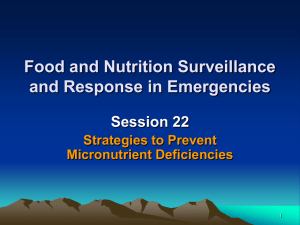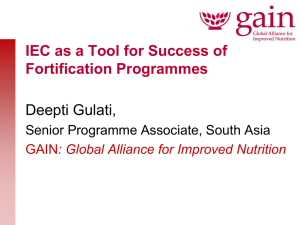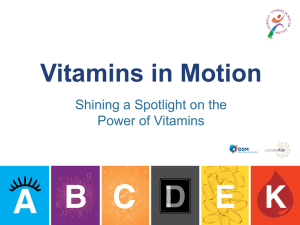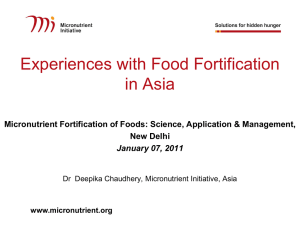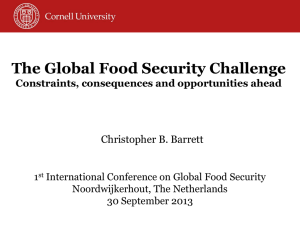TUAB006 – A Health Systems Strengthening Approach To Improve
advertisement
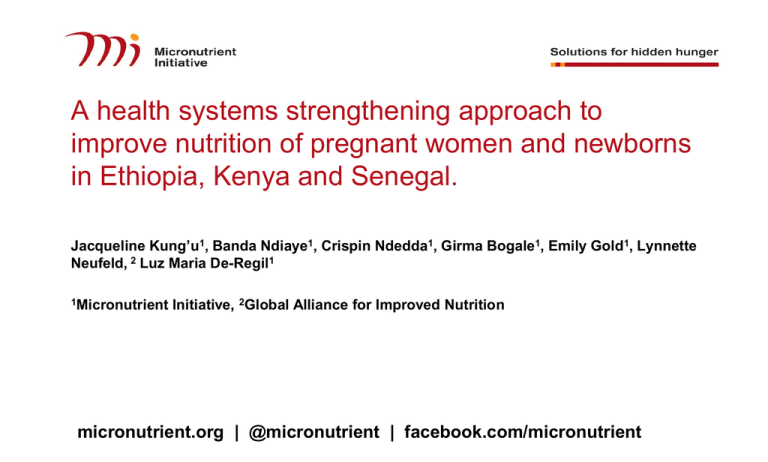
A health systems strengthening approach to improve nutrition of pregnant women and newborns in Ethiopia, Kenya and Senegal. Jacqueline Kung’u1, Banda Ndiaye1, Crispin Ndedda1, Girma Bogale1, Emily Gold1, Lynnette Neufeld, 2 Luz Maria De-Regil1 1Micronutrient Initiative, 2Global Alliance for Improved Nutrition micronutrient.org | @micronutrient | facebook.com/micronutrient Introduction • Pregnant women and newborns are among the vulnerable populations in any community • We commissioned demonstration projects to generate evidence for strengthening the health systems to ensure pregnant and newborns are reached with proven health and nutrition interventions • Approach used in each country suitable to existing health system context micronutrient.org @micronutrient @micronutrient facebook.com/micronutrient facebook.com/micronutrient 2 Community Based Maternal and Newborn Health projects 1. Ethiopia Supporting Ethiopia’s Health Extension Program to increase access to quality maternal, neonatal and nutrition services 2. Kenya Improved care and Nutrition for Women at Risk during Pregnancy through a Novel Community-Facility Linkage program 3. Senegal Development and piloting of comprehensive Maternal and Newborn Community Health (MNCH) policy for Senegal. Maternal and Neonatal morbidity and mortality reduced micronutrient.org @micronutrient @micronutrient facebook.com/micronutrient facebook.com/micronutrient 3 Program Theory - Ethiopia Input MNHN training guidelines and booklet Monitoring and Collaborative Quality Improvement (CQI) at Health Facilities Impact Outcomes Providers Knowledge, Skill, and Commitment on MNHN services improved Improved MNHN Service Quality Maternal and Neonatal morbidity and mortality reduced Supply and Medical equipment improved Improved MNHN Service uptake Knowledge, skills and practice of Guide Team s & CQI Teams at the community to improve demand for MNHN services Access: Availability of trained Guide team in the community that provides MNHN services micronutrient.org @micronutrient @micronutrient facebook.com/micronutrient facebook.com/micronutrient 4 Program Theory - Kenya Health facility strengthening Community mobilization and Referral (Demand creation) Input Outcomes Impact Behavior change Interventions at the community CHW training Facilities TBA orientation Increased MNH & Nutrition knowledge TBAs as birth companions Incentive package Collective and individual Teamwork and simulation training (PRONTO) Intervention only Harmonized EmONC Training (MoH) Intervention & Comparison Increased demand for services Increased utilization of services Improved care & nutrition of pregnant women & newborns Maternal and Neonatal morbidity and mortality reduced Retention of CHWs in program Improved skills and knowledge micronutrient.org @micronutrient @micronutrient facebook.com/micronutrient facebook.com/micronutrient 5 Program Theory- Senegal Outcomes Input Formation of and training of facilitators of influencer and pregnant women peer groups Matron, Bajenou Gox and Relay trained and have effective communication strategy (ECS)) Delayed and quality care umbilical cord clamping Delivery with trained provider in community (low risk) Health extension workers trained and have ECS Comprehensive package of MNH services designed New health huts enlisted and equipped Supply and distribution issues resolved for misoprostol, IFA, MgSO4 loading dose (at health post only) Impact Decreased PPH Maternal and Neonatal morbidity and mortality reduced Mesoprostol use MgSO4 loading dose use at health post Early ANC Quality ANC, including effective counselling Appropriate use of iron-folic acid supplements Child birth preparation Early and exclusive breastfeeding Decreased anemia prevalence in pregnant women Decreased Newborn Infection micronutrient.org @micronutrient @micronutrient facebook.com/micronutrient facebook.com/micronutrient 6 Quasi experimental study design using mixed methods Baseline assessment (Qualitative + Quantitative) 2013 1. Mothers with children 0-11 mths 2. Pregnant women 3. CHW/HEW 4. TBA 5. HF Staff No random assignment Intervention + Comparison Intervention Ethiopia - Integrated set of activities and essential services Kenya - Community facility Linkage Senegal – Pilot the defined package of services at community level Process/Midterm evaluation – Evaluate the process of implementing the intervention micronutrient.org Endline assessment (Qualitative + Quantitative) 2015 Measure the impact of intervention on various outcome and impact indicators @micronutrient @micronutrient facebook.com/micronutrient facebook.com/micronutrient 7 ANC Visits Indicator Intervention Comparison Kenya Ethiopia Senegal Kenya Ethiopia Senegal n/N (%) n/N (%) n/N (%) n/N (%) n/N (%) n/N (%) % of mothers of children 011 m of age who attend ANC at least 4 times during most recent pregnancy. 178/413 43% 48/998 4.8% 202/1086 18.6% 99/204 48.5% 28/971 2.9% 146/350 41.7% % of mothers of children 011 m of age who received ANC in the first trimester during most recent pregnancy 79/427 18.5% 51/246 20.7% 330/1094 30.2% 19/204 9.3% 56/107 24.3% 177/392 45.2% micronutrient.org @micronutrient @micronutrient facebook.com/micronutrient facebook.com/micronutrient 8 IFA utilization Indicator Intervention Comparison Kenya Ethiopia Senegal Kenya Ethiopia Senegal n/N (%) n/N (%) n/N (%) n/N (%) n/N (%) n/N (%) % of mothers of children 011 m of age who report having taken IFA during the latest pregnancy ≥ 90 d 105/286 36.7% 6/177 3.4% 760/1367 55.6% 45/109 41.3% 13/212 6.1% 379/442 85.7% % of mothers of children 011 m of age who report having taken any IFA during pregnancy 309/464 66.6% 178/995 17.8% 1020/1444 70.6% 131/218 60.1% 211/971 21.7% 389/481 79.6% micronutrient.org @micronutrient @micronutrient facebook.com/micronutrient facebook.com/micronutrient 9 Understanding Barriers to and Opportunities for ANC in Kenya: Pregnant Women The pregnant women and mothers of young children were all positive about ANC especially because of the check-ups, vaccinations and the fact that they receive a mosquito net. Reasons given by some for not visiting ANC : • ANC is not beneficial - especially in the first trimester • The hospital smell is offensive • Their mothers-in-law do not encourage them to seek ANC and so they do not attend to please them (this contradicts some of the responses from mothers in-laws, who said, for example, that the women are simply lazy and don’t attend ANC) • They find the process of being examined very tiresome • Fear of being tested for HIV. micronutrient.org @micronutrient @micronutrient facebook.com/micronutrient facebook.com/micronutrient 10 Understanding Barriers to and Opportunities for ANC in Ethiopia: Women • • • Most participants believed that there is no need to go for ANC services as the services are meant for pregnant women who are sick. Those who had ANC visit noted that health care providers were doing nothing if the mother and fetus are healthy during the visit. A mother of nine children from Golina Botena district remarked “ I didn’t use ANC services because I was healthy. A woman should go for antenatal care services if she gets ill” On the other hand, in depth interview participants indicated that women who had a problem during their pregnancy go to health institutions for repeated follow-up micronutrient.org @micronutrient @micronutrient facebook.com/micronutrient facebook.com/micronutrient 11 Understanding Barriers to and Opportunities for ANC in Senegal : Lactating women, Husband, Mother in-law • Geographical barriers-- All participants stated that distance was a critical barrier and inaccessible roads. • Cultural barriers – “…Husbands should get more involved on aspects of ANC. Their support is only financial…”(Mother in-law). • “…Women are used to hiding their pregnancy and always inform us late to avoid evil spirit…” (Husband). • Training barriers-- “…The health workers are not patient or lack training…” (Husband) • BCC barriers – “...Religious and traditionalists ignore the benefits of IFA and propose healing plants due to lack of sensitization…” (Mother in-law) • Opportunities- Women who had received advices on ANC were more likely to do it early and completely micronutrient.org @micronutrient @micronutrient facebook.com/micronutrient facebook.com/micronutrient 12 Health facility Staff, Mothers in Law and Midwives According to the health facility staff, women come for ANC: • Late, usually when they are about 6 months or even near term • when they are sick or have a problem • when they cannot afford or pay for services The following are considered to be greatest worries and most common problems facing pregnant women in the community: • Facilities being too far; Lack of transport - especially at night; Diseases (such as malaria, HIV); Anemia, poor nutrition; Poverty, polygamy; Unaffordable hospital charges ; Ignorance According to mothers in-laws and mid-wives ,pregnant women should make ANC visits early enough, preferably at three months gestation period. Reasons they indicated for women not attending ANC as required included: • Laziness; Ignorance; Fear of harsh facility service providers (although the retired mid-wives were previously health service providers); Financial constraints; Distance; Fear of injections/drugs micronutrient.org @micronutrient @micronutrient facebook.com/micronutrient facebook.com/micronutrient 13 Postnatal Care Indicator Intervention Kenya Ethiopia Comparison Senegal Kenya Ethiopia Senegal n/N (%) n/N (%) n/N (%) n/N (%) n/N (%) n/N (%) % of lactating women who initiate breastfeeding within one hour after birth. 276/297 92.9% 365/967 37.7% 743/4101 53% 117/135 86.6% 522/961 54.3% 232/439 52.8% % of mothers of children 011 m of age who delivered with skilled attendant 81/258 31.4% 63/997 6.3% 801/1433 55.9% 66/119 55.5% 58/971 6% 276/467 59.1% % of women who received post natal care 48 hours after delivery 235/272 86.4% 11/18 61.1% 964/1397 59% 144/147 98% 21/26 80.8% 403/455 88.6% micronutrient.org @micronutrient @micronutrient facebook.com/micronutrient facebook.com/micronutrient 14 Understanding Barriers to and Opportunities for Facility Based Post natal Care and breastfeeding in Senegal • Financial barriers– “…Certain mothers are obliged to work to have some money and leave baby to mother in- law…”(Matron). • Cultural barriers resulting from mother -in-law– “…It is the fault of mothers-inlaw who ignore the nutritional values of the Breastfeeding…” (Matron) • Opportunities– Period of breastfeeding initiation and duration of exclusive breastfeeding are well-know by CHWs– “… The breastfeeding should start immediately after the baby born…” (Bajenu Gox) micronutrient.org @micronutrient @micronutrient facebook.com/micronutrient facebook.com/micronutrient 15 Understanding Barriers to and Opportunities for Exclusive Breastfeeding in Kenya - TBAs • The TBAs are aware of the need for six months of exclusive breastfeeding, but some children start crying after breastfeeding – this is taken as a sign that breast milk is not enough and as such start being fed porridge. • TBAs said that apart from breast milk, a woman can give porridge made from millet to the child. At four months, the mother can start giving avocados and pawpaws. A mother will know that she is supposed to wean because some children will want to eat what the mother eats at the age of 4 months micronutrient.org @micronutrient @micronutrient facebook.com/micronutrient facebook.com/micronutrient 16 Understanding Barriers to and Opportunities for breastfeeding in Ethiopia In-depth interview participants raised several reasons for not giving first milk (colostrum). • the first milk is contaminated with dirt which gets in through the nipples. This milk is discarded and the next fresh milk which is assumed to be cleaner is given to the baby. • discarding the first milk will enable to initiate production of adequate milk subsequently. • if the first milk, which stayed for long and exposed to the sun is given to the new born, it can cause abdominal pain. micronutrient.org @micronutrient @micronutrient facebook.com/micronutrient facebook.com/micronutrient 17 Understanding Barriers to and Opportunities for breastfeeding in Ethiopia • In some instances herbal medicines are given to the newborn to make the child well as s/he grows. “ It is our culture that the baby is given a medicine so that he will be a good person when he grows up. The father brings the herb and it will be mixed with milk and will be given to the baby” (a mother from Ewa district). micronutrient.org @micronutrient @micronutrient facebook.com/micronutrient facebook.com/micronutrient 18 Conclusions and Next Steps • Maternal health service utilization was found to be very low and presents an opportunity for CBMNH intervention to make a difference • ANC in first trimester needs to be promoted more than “any” contact during pregnancy • Completed ANC needs to be promoted by sensitization and more involvement of community groups • Emphasis has been put on BCI to address key project components during pregnancy, delivery and PNC– maternal nutrition, breastfeeding practices, cord care micronutrient.org @micronutrient @micronutrient facebook.com/micronutrient facebook.com/micronutrient 19 Acknowledgements • Communities • All partners – MoH, ManHEP, University of Addis Ababa, AMREF, PRONTO, ChildFund, University of Nairobi, Université Cheikh Anta Diop – ISED. • DFATD micronutrient.org @micronutrient @micronutrient facebook.com/micronutrient facebook.com/micronutrient 20
